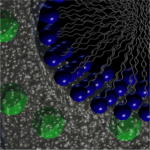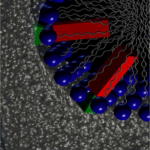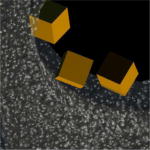Table I.
The Different Structural Regions of Mesostructured Silicates and Techniques for Derivatization
| Structural region | Method of derivatization | Description of method | Examples of utility |
|---|---|---|---|
| Framework | Bonding | Active molecules themselves form a part of the silica framework. They undergo hydrolysis and condensation during synthesis to become incorporated into the final framework. | Placement of photoactive and electroactive metal complexes for energy and electron transfer. |
 |
|||
| Organic | Philicity | The local solubility of the active molecules determines their placement. Hydrophobic molecules assemble into the micelle interior during synthesis | Placement of pyrene to probe micelle formation; placement of acceptor molecules for energy and electron transfer. |
 |
|||
| Ionic interface | Bifunctional | An active molecule is chemically bonded to the outside of the framework. The active molecule usually contains one end that is a trialkoxysilane capable of bonding to the framework, and the other end that is hydrophobic. | Placement of azobenzene-based nanoimpellers. |
 |
|||
| Exterior surface | Postsynthetic grafting | The exposed surfaces are derivatized after synthesis by treating the material with a molecule capable of reacting with silica. | Placement of nanovalves and snap-tops. |
 |
